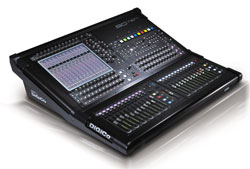DiGiCo has announced the debut of the SD10-24, a console that boasts features and benefits that instantly distinguish it from the others in the SD Series, just in a more compact package.
“When we introduced the SD8-24, which was primarily designed with the corporate market in mind, it was an immediate hit,” says James Gordon, DiGiCo’s managing director. “The SD10-24 is based on the same thinking; to provide a smaller footprint console for a particular segment of the market, but with no reduction in functionality or number of inputs and outputs.
“With the SD10-24 we have smaller venues in mind and, because we also have the SD10-B broadcast specific product, we are producing an SD10B-24 as well, which we are confident will be particularly useful for OB trucks, where space is often very limited but a high channel and buss count is required to handle 5.1 audio systems.”
The SD10-24 measures just under 3 feet in width, with a worksurface constructed from anodized aluminum, overlaid with polycarbonate panels to provide clear and concise user feedback. It has the same large 15-inch, touch sensitive screen as the SD Ten, providing both information and fast control of all the main parameters.
The control surface features 25 100mm touch sensitive faders, providing fast access to the console’s large number of channels, which include 96 with full processing, 12 of which can be configured as full Flexi Channels – and outputs that can be assigned across the surface. All inputs have dual mono inputs for fast ‘Main’ and ‘Alt’ channel switching.
Smart Key Macros are provided, accessed via four layers of ten backlit LCD keys. The user can program these to control any functions, simple or complex, that they want to recall at the push of a button.
Local I/O, positioned on the rear of the console, comprises eight mic inputs, eight line outputs, eight mono AES I/O, two MADI connections with redundant cabling connections, 16 GPI and GPO connections, MIDI, plus Wordclock, MADI and Optocore for synchronisation.
Standard input channel processing includes channel delay; single and multi channel presets; HPF and LPF with 24 dB per octave; four bands of parametric EQ with band curve selection; compressor and date; dual insert points and access to all busing.
Standard output channel processing includes output delay; eight bands of parametric EQ (previously only seen on the SD7); compressor and gate; dual insert points; groups with bus to buss routing, plus Auxes that have direct talk to output with dim control.




















